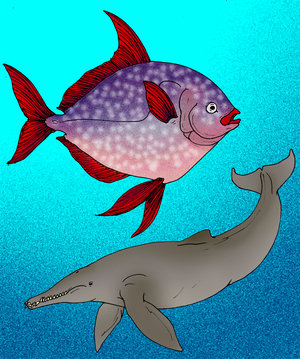Waipatia facts for kids
Quick facts for kids Waipatia |
|
|---|---|
 |
|
| The fish Megalampris (above) and W. maerewhenua (below) | |
| Scientific classification |
|
| Kingdom: | Animalia |
| Phylum: | Chordata |
| Class: | Mammalia |
| Order: | Artiodactyla |
| Infraorder: | Cetacea |
| Parvorder: | Odontoceti |
| Superfamily: | Platanistoidea (?) |
| Family: | †Waipatiidae Fordyce, 1994 |
| Genus: | †Waipatia Fordyce, 1994 |
| Species | |
|
|
| Synonyms | |
|
|
Waipatia was an extinct type of whale that lived a very long time ago, during the late Oligocene period. Its fossils have been found in New Zealand. This ancient whale was a toothed whale, meaning it had teeth, unlike some modern whales that have baleen plates for filtering food.
Contents
Discovering Waipatia
Scientists first learned about Waipatia from a single skull fossil. This important fossil was discovered in a place called Otago, which is located in the southern part of New Zealand. The discovery of this skull helped scientists understand more about the types of whales that swam in the oceans millions of years ago.
Two Species of Waipatia
Currently, scientists recognize two different species of Waipatia. The first one, named Waipatia maerewhenua, is the "type species." This means it's the main example that defines the whole group. The second species is called Waipatia hectori.
How W. hectori Got Its Name
The story of Waipatia hectori's name is a bit interesting! It was first named Microcetus hectori way back in 1935. However, later on, scientists realized it wasn't actually part of the Microcetus group. For a while, it had an informal name, "Uncamentodon," but this name wasn't officially accepted because it didn't have a proper description. Finally, in 2015, after more fossil pieces were studied, scientists officially recognized it as a second species of Waipatia.
What Was the Oligocene Period Like?
Waipatia lived during the Late Oligocene epoch, which was about 28 to 23 million years ago. During this time, the Earth's climate was generally warmer than it is today, and sea levels were higher. The oceans were full of diverse marine life, including many different types of whales, sharks, and other sea creatures. Waipatia would have shared its ocean home with other early whales and the ancestors of modern marine animals.
How Do We Learn About Extinct Whales?
Scientists called paleontologists study fossils to learn about animals that lived long ago and are now extinct. When they find a fossil, like the skull of Waipatia, they carefully dig it up and then study its shape and features. By comparing these ancient bones to the bones of modern animals, they can figure out what the extinct animal looked like, what it ate, and how it might have lived. Fossils are like clues from the past that help us piece together Earth's history!
See also
 In Spanish: Waipatia para niños
In Spanish: Waipatia para niños

